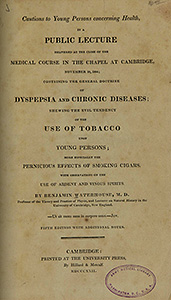-
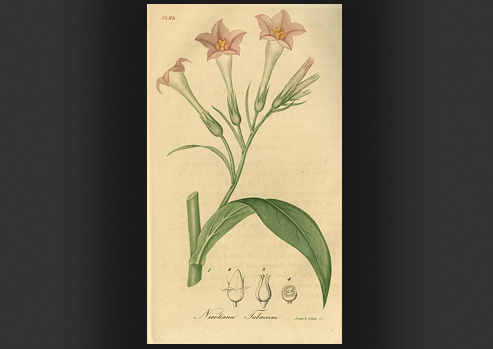
Illustration of Nicotiana Tabacum from Jacob Bigelow, American Medical Botany, 1817
Courtesy National Library of Medicine
 BOTANICAL, Nicotiana Tabacum
BOTANICAL, Nicotiana TabacumPLXL.
Nicotiana Tabacum Annin… Smith Sc -
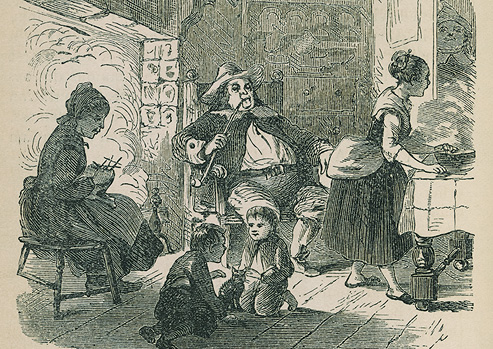
Household in the old Dutch colony times, 1859
Courtesy New York Public Library
 CURATIVE, “God’s remedy”
CURATIVE, “God’s remedy”Settlers used tobacco leaves to treat ulcerated skin, wounds, and burns, sniffed the fresh plant for headaches, rubbed powdered leaves around the mouth for colds and catarrh, and smoked or chewed tobacco to improve digestion, to ward off hunger and thirst, and for pain relief.
-
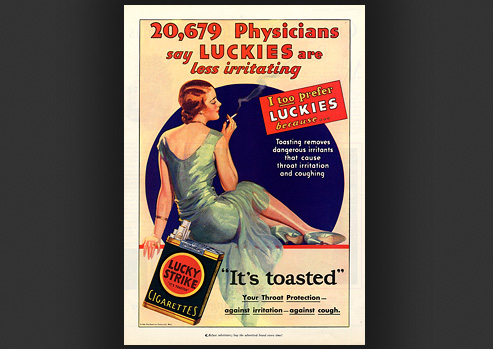
Advertisement for Lucky Strike cigarettes, The American Tobacco Co., 1930
Courtesy National Museum of American History [Jackler Collection/Archives]
 MARKET, Marketing Emancipation
MARKET, Marketing EmancipationSmoking by women was originally considered a sign of disrepute. By the 1920s, glamorous depictions of women smoking began to appear in movies and cigarette advertisers began to appeal to them directly. Smoking cigarettes soon came to be seen as a symbol of the modern, emancipated woman.
20,679 Physicians say LUCKIES are less irritating
I too prefer LUCKIES because…
Toasting removes dangerous irritants that cause throat irritation and coughing
LUCKY STRIKE
“IT’S TOASTED”
CIGARETTES
“It’s toasted”
Your Throat Protection – against irritation – against cough.
©1930, The American Tobacco Co., Mirs.
Refuse substitutes; buy the advertised brand every time! -
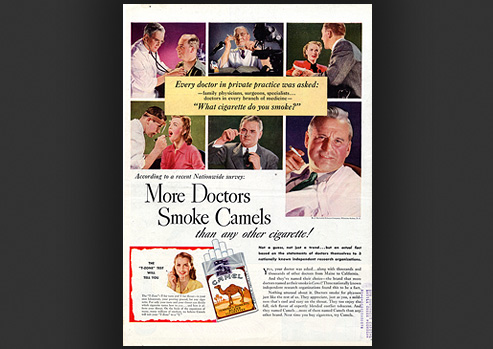
Advertisement claiming more doctors smoked Camel cigarettes than any other, R. J. Reynolds Tobacco Company, ca. 1950
Courtesy National Museum of American History [Jackler Collection/Archives]
 MARKET, Selling Smooth Flavor
MARKET, Selling Smooth FlavorAs evidence of the health risks of smoking mounted, tobacco companies cast doubts on medical data and advertised smoother and lighter blends as safer versions of the standard cigarette. In 1946, the Camel company launched an eight-year magazine and radio campaign claiming that more doctors smoked their brand than any other. These efforts were so successful, along with the addictive properties of nicotine and a lack of strong incentives to drop the habit, that smoking did not begin to decline in the United States until the publication of the Surgeon General’s first report on the subject in 1964.
Every doctor in private practice was asked:
—family physicians, surgeons, specialists… doctors in every branch of medicine—
“What cigarette do you smoke?”According to a recent Nationwide survey:
More Doctors Smoke Camels than any other cigarette!Not a guess, not just a trend… but an actual fact based on the statements of doctors themselves to 3 nationally known independent research organizations.
YES, your doctor was asked… along with thousands and thousands of other doctors from Maine to California.
And they’ve named their choice – the brand that more doctors named as their smoke is Camel! Three nationally known independent research organizations found this to be a fact.
Nothing unusual about it. Doctors smoke for pleasure just like the rest of us. They appreciate, just as you, a mildness that’s cool and easy on the throat. They too enjoy the full, rich flavor of expertly blended costlier tobaccos. And they named Camels… more of them named Camels than any other brand. Next time you buy cigarettes, try Camels.
THE “T-ZONE” TEST WILL TELL YOU
The “T-Zone” – T for taste and T for throat – is your own laboratory, your proving ground, for any cigarette. For only your taste and your throat can decide which cigarette tastes best to you… and how it affects your throat. On the basis of the experience of many, many millions of smokers, we believe Camels will suit your “T-Zone” to a “T”.
CAMEL
TURKISH & DOMESTIC BLEND CIGARETTES
CHOICE QUALITY
R.J. Reynolds Tobacco Company, Winston-Salem, N.C. -
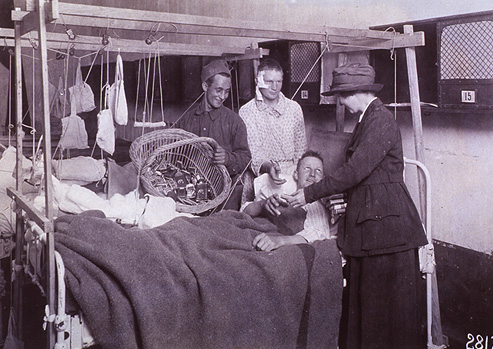
Red Cross worker distributing cigarettes to injured soldiers, 1918
Courtesy National Library of Medicine
 CONSUMER, Pleasure and Tobacco
CONSUMER, Pleasure and TobaccoProfessional as well as working men enjoyed chewing tobacco, snuff, and pipe smoking, and by the nineteenth century, cigars were a symbol of wealth and power for the upper class. During the First World War, the popularity of cigarettes was spurred on by the distribution of free supplies to soldiers.
-
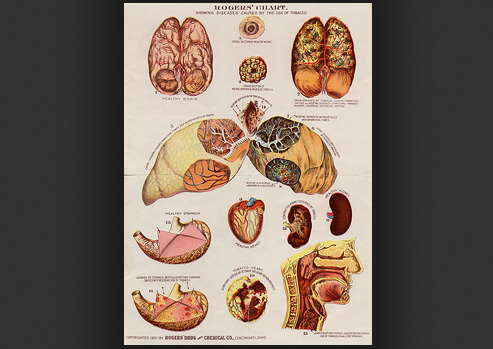
Rogers’ Chart. Showing diseases caused by the use of tobacco, Rogers’ Drug and Chemical Co., 1901
Courtesy National Museum of American History
 PROHIBITIVE, Poisonous Smoke
PROHIBITIVE, Poisonous SmokeThe negative health effects of tobacco were noted early on. Physicians became increasingly cautious about tobacco as a medicine because of its poisonous qualities. However, smoking did not begin to decline in the United States until the publication of the Surgeon General’s first report on the subject in 1964.
ROGERS’ CHART
SHOWING DISEASES CAUSED BY THE USE OF TOBACCO.
1 HEALTHY BRAIN.
2 BRAIN DISEASED BY TOBACCO, SHOWING CONGESTED PATCHES AND NICOTINE DEPOSITS SYMPTOMS: IMPAIED MEMORY, HEADACHE, DIZZINESS, VERTIGO.
3 CROSS SECTION OF HEALTHY NERVE.
4 CROSS SECTION OF NERVE DISEASED BY USE OF TOBACCO.
5 LUNG: SHOWING TISSUES, BRONCHIAL TUBES AND BLOOD VESSELS IN HEALTH.
6 LUNG DISEASES AND SHRUNKEN BY CIGARETTE SMOKING.
7 NICOTINE DEPOSITS IN TISSUE CELLS AND BRONCHIAL TUBES
8 NICOTINE ALBUMINOUS HARDENING IN BLOOD VESSELS.
9 HEALTHY HEART
10 TOBACCO- HEART. SYMPTOMS: IRREGULAR ACTION OF THE HEART OF PAIN AROUND IT.
11 HEALTHY KIDNEY.
12 CONTRACTED KIDNEY DISEASED BY TOBACCO.
13 CANCER OF THE THORAT, CAUSED BY EXCESSIVE USE OF TOBACCO, USUALLY BY SMOKING.
14 NICOTINE DEPOSITS IN THE TRACHEA OR WINDPIPE
15 HEALTHY STOMACH
16 CATARRH OF STOMACH, WITH ULCERATIONS FORMING, CAUSED BY EXCESSIVE USE OF TOBACCO.
COPYRIGHTED 1901 BY ROGERS’ DRUG AND CHEMICAL CO., CINCINNATI. OHIO -
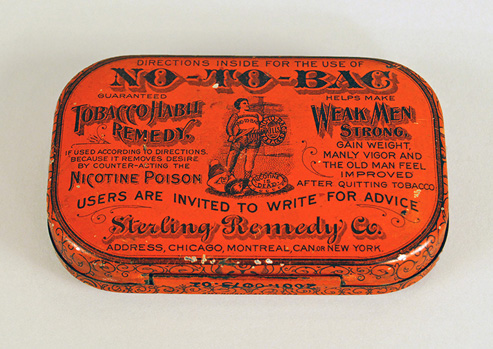
No-To-Bac, Sterling Remedy Co., 1906–1908
Courtesy National Museum of American History
 PROHIBITIVE, Cure the Habit
PROHIBITIVE, Cure the HabitNo-To-Bac, a chewing gum containing licorice, plant materials, and salt, was one of several products marketed as a cure to the tobacco habit. The remedy was marketed to men, the main users of tobacco at the time, as a means to restore manly vigor and virility imperiled by nicotine use.
DIRECTIONS INSIDE FOR THE USE OF NO – TO – BAC
GUARANTEED TOBACCO HABIT REMEDY,
IF USED ACCORDING TO DIRECTIONS. BECAUSE IT REMOVES DESIRE BY COUNTER-ACTING THE NICOTINE
POISON
HELPS MAKE WEAK MEN STRONG, GAIN WEIGHT, MANLY VIGOR AND THE OLD MAN FEEL IMPROVED AFTER QUITTING TOBACCO
USERS ARE INVITED TO WRITE FOR ADVICE
Sterling Remedy Co.
ADDRESS, CHICAGO, MONTREAL, CAN. OR NEW YORK.
NO-TO-BAC KILLS TOBACCO
NICOTINE IS DEAD -
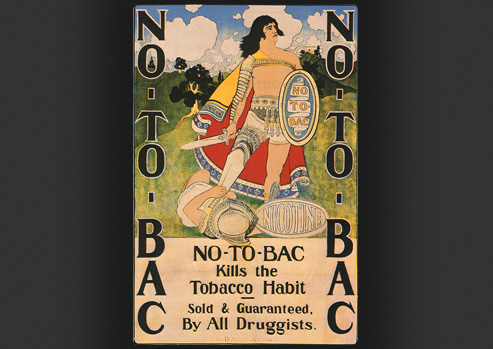
Maxfield Parrish, No-To-Bac advertisement, ca. 1900 (reproduction 1986)
Courtesy National Library of Medicine
 PROHIBITIVE, Cure the Habit
PROHIBITIVE, Cure the HabitNo-To-Bac, a chewing gum containing licorice, plant materials, and salt, was one of several products marketed as a cure to the tobacco habit. The remedy was marketed to men, the main users of tobacco at the time, as a means to restore manly vigor and virility imperiled by nicotine use.
NO – TO – BAC
NO – TO – BAC
Kills the Tobacco Habit
Sold & Guaranteed, By All Druggists.
NO – TO – BAC
NICOTINE
THE DANDO PRINT PHILA-
For generations, Native Americans have smoked pipes full of dried tobacco leaves for spiritual and social purposes and used the plant in medicinal remedies. Tobacco became known among English settlers as “God’s remedy” for its many uses. Smoking has endured as a popular pastime despite early evidence of tobacco’s dangerous effects. Regular users were labeled “slaves” to their habit. This reflects not just the addictive properties of the tobacco alkaloid, nicotine, but the great success of advertising, which helped to foster the habit among women as well as men, rich and poor, at work and at play.


